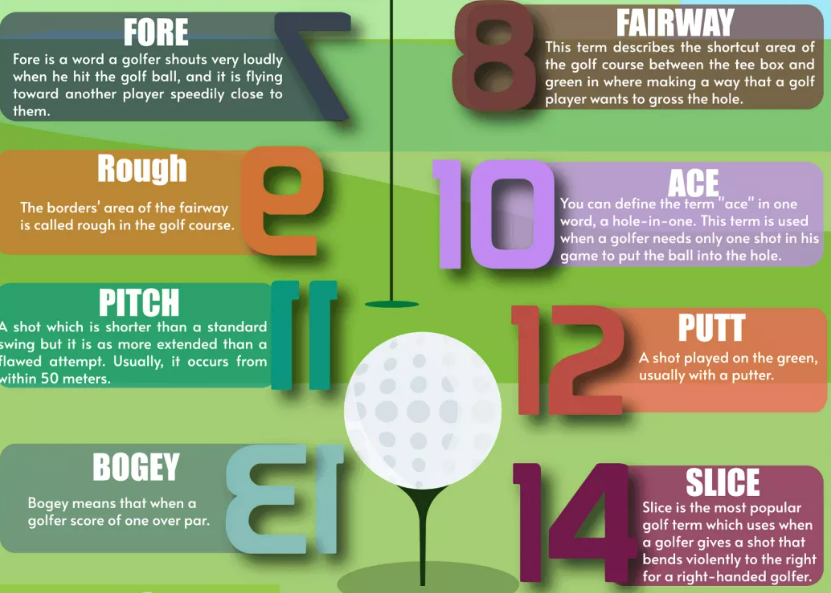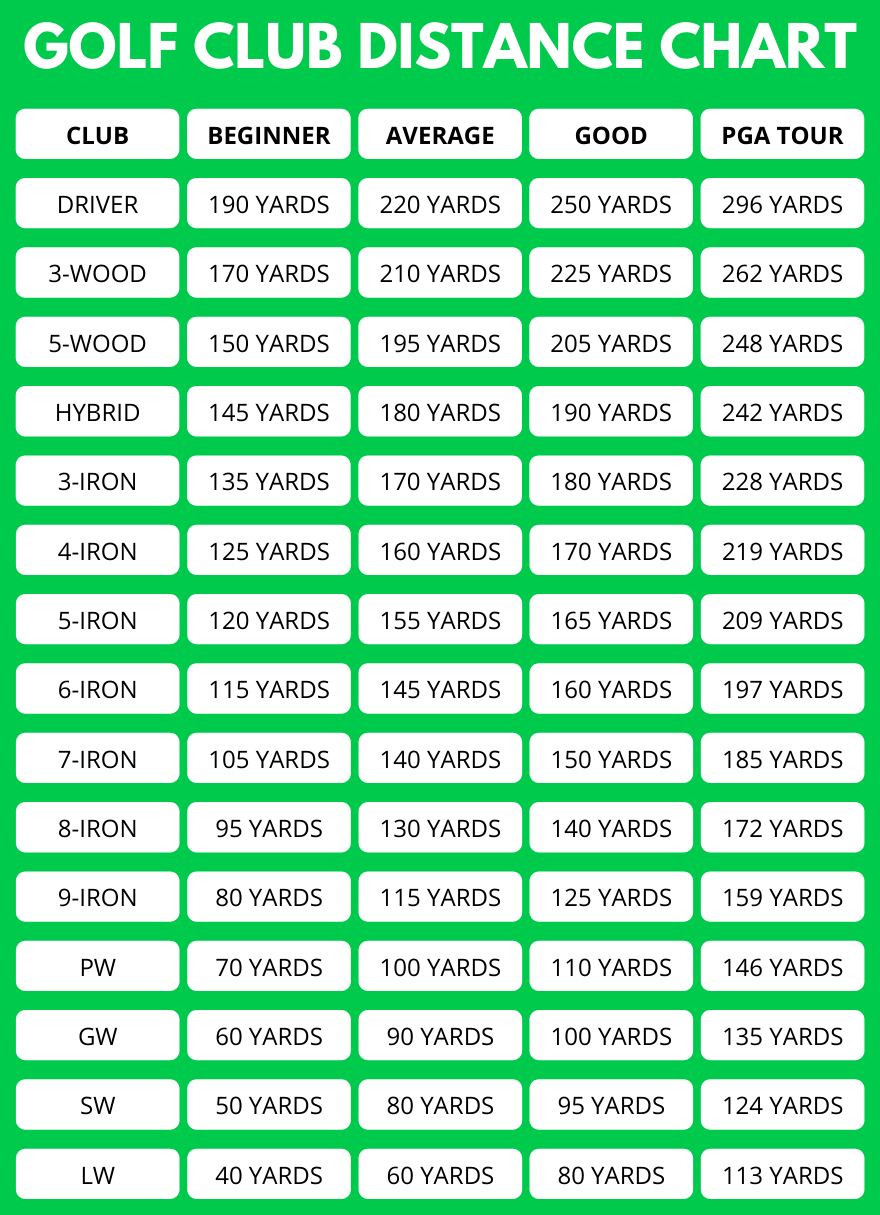Learning golf vocabulary is almost like learning another language. The more you practice, the more it will make sense. This page contains videos and links to other important information for you to know about golf. Click on the black boxes for a deeper dive.
BASICS:
Golf is played on a golf course with golf clubs and a golf ball. The ultimate goal is to get your ball from the tee box into the hole on the putting green. Most golfers play 18 holes but some elect to play only 9. The first nine holes are called the front 9 and the last, the back 9. Par is the maximum amount of times you should make contact with the ball. Par is usually 72 for 18 holes, and 36 for 9 holes but it takes skill to accomplish this goal.
Golf is played on a golf course with golf clubs and a golf ball. The ultimate goal is to get your ball from the tee box into the hole on the putting green. Most golfers play 18 holes but some elect to play only 9. The first nine holes are called the front 9 and the last, the back 9. Par is the maximum amount of times you should make contact with the ball. Par is usually 72 for 18 holes, and 36 for 9 holes but it takes skill to accomplish this goal.
There are several types of golf clubs which can be used anywhere on the course. Each is designed for a specific purpose depending on where the ball lands but a creative golfer may use them in unconventional ways for difficult situations.
Once you understand what each of the clubs in your bag are called, it is important to know how far you can "hit" the ball with each club. Knowing this information will allow you to make better choices when you are playing a round a golf. For example, if you are playing a 300 yard Par 4 and your drive rolls out leaving 145 yards left to the pin for your second shot, you will need to know which of your irons will get you there in 2 to have a chance for a birdie putt or maybe your best iron shot only goes 125 so you take the shot and expect to chip onto the green for your 3rd and roll the putt in for 4.
The chart that follows is a general guideline to understand how far clubs can generally go if you make the perfect golf swing but it is only a guideline. Your game is your game, develop it and do not compare it to others.
The chart that follows is a general guideline to understand how far clubs can generally go if you make the perfect golf swing but it is only a guideline. Your game is your game, develop it and do not compare it to others.
GOLF SKILLS:
There are four basic shots in golf. The full swing, the pitch, the chip and the putt. The pitch, the chip and the putt are part of the short game which is extremely important in golf. Most amateur golfers focus most of their attention on the full swing not realizing that the game is won by the person with the best short game.
There are four basic shots in golf. The full swing, the pitch, the chip and the putt. The pitch, the chip and the putt are part of the short game which is extremely important in golf. Most amateur golfers focus most of their attention on the full swing not realizing that the game is won by the person with the best short game.
This video features Rick Shiels of the United Kingdom and one of his students. This video gives you an idea of the different types of golf holes you will encounter when playing.
In this video, Rick Shiels visits Florida and plays a round at the Palm Beach Par 3. Juniors can play the Palm Beach Par 3 course for $5 if they join Youth on Course. Click here for details.
Every hole is a par 3 which means your goal is to put the ball in the hole in 3 shots or less. In a perfect world, your tee shot would end up on the green. Then you would be putting for birdie and if you miss, tap it in for par. As you watch Rick play, you will discover it is not always that easy.
Every hole is a par 3 which means your goal is to put the ball in the hole in 3 shots or less. In a perfect world, your tee shot would end up on the green. Then you would be putting for birdie and if you miss, tap it in for par. As you watch Rick play, you will discover it is not always that easy.
RULES:
First and foremost, golf is a game of etiquette. Undoubtedly, there a lot of rules to learn but it is more pleasant to play with a golfer who is courteous, respectful and willing to learn the rules than a golfer who is knows the rules but is completely self-absorbed and rude.
There is no referee in golf so you are responsible for playing by the rules. This means you will be living out the core values of honesty and integrity with every shot you take on the course even when you are playing alone. This means counting all strokes and any penalties. The best way to become comfortable with the rules is to review them regularly and stay up to date with any changes.
First and foremost, golf is a game of etiquette. Undoubtedly, there a lot of rules to learn but it is more pleasant to play with a golfer who is courteous, respectful and willing to learn the rules than a golfer who is knows the rules but is completely self-absorbed and rude.
There is no referee in golf so you are responsible for playing by the rules. This means you will be living out the core values of honesty and integrity with every shot you take on the course even when you are playing alone. This means counting all strokes and any penalties. The best way to become comfortable with the rules is to review them regularly and stay up to date with any changes.
Professional Golf Tidbits
Masters Tournament was created by Bobby Jones. It is an iconic invite only golf tournament held annually since 1934 at Augusta National Golf Club in Augusta, Georgia. It is considered one of the four “majors” which includes the U.S. Open, the Open Championship and the PGA Championship.
Masters Tournament was created by Bobby Jones. It is an iconic invite only golf tournament held annually since 1934 at Augusta National Golf Club in Augusta, Georgia. It is considered one of the four “majors” which includes the U.S. Open, the Open Championship and the PGA Championship.
Three of the men's four major tournaments have an equivalent for the women but the Masters is not one them. In addition to the US Open, the Women's Open and the PGA Championship, the women play in two other majors - the Chevron Championship and the Amundi Evian Championship.
|
|
|
|
|
Homeschool Palm Beach Copyright 2022. All rights reserved.
Republishing any personal content or photography from this website is prohibited.
Republishing any personal content or photography from this website is prohibited.


